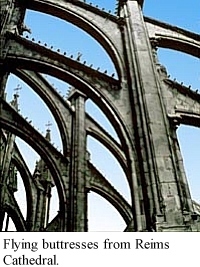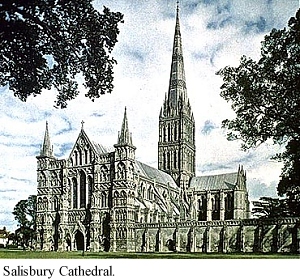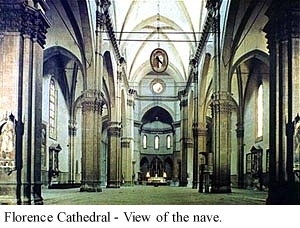The End of Europe's Middle Ages
This chapter is composed of four sections: Introduction, Architecture, Sculpture and Painting. Please follow the link at the end of each section to read the entire chapter.
Architecture
By the beginning of the fourteenth century, the great outpouring of religious fervour that had resulted in the Age of the Great Cathedrals had abated. The soaring Gothic architecture of the twelfth and thirteenth centuries required vast resource pools of men and materials. Following the demographic decimation of war, famine, and plague, building projects diminished in both size and number. During the Late Middle Ages, more secular buildings were constructed, allowing an opportunity to explore the classical themes and styles that would shape the Renaissance.
The Gothic style that originated with Abbot Suger's rebuilding of the royal Abbey Church of St.-Denis in the mid- twelfth century initiated a new style of architecture referred to as Gothic. Countering the massive heaviness of the Romanesque style, Gothic architecture soared to new heights and vast expanses of windows allowed light to pour into the interior. Structural innovations made this new architectural style possible. The outward pressures of the lofty ceiling were absorbed not by the walls, as had always been the case previously, but instead by flying buttresses located on the exterior of the building. Walls were no longer needed to support the weight of the structure. This allowed the architects to replace that surface almost entirely with windows. From narrow slits, which let in very little light, windows expanded to incredible dimensions, illuminating the interior.
The most stunning aspects of Gothic cathedrals are the impressive "verticalism" of the buildings, the brightness of the interiors, and the brilliance of the stained glass that filled the massive windows.
By the late thirteenth and early fourteenth centuries, the religious piety that carried cathedrals such as Chartres, Amiens, and Reims to such breathtaking heights began to subside and refinement of detail replaced the quest for height. In France, the Late, or Flamboyant phase of Gothic architecture began in the late thirteenth century and is characterised by a profusion of ornamentation, the aim of the architect being to disguise and camouflage structural supports. The development of Flamboyant Gothic was interrupted by the Hundred Years' War and mature examples of the style do not appear until the fifteenth century, with few structural innovations occurring in the intervening period.
The Gothic style took root more slowly in Germany than it did in either England or France and it was not until the thirteenth century that Early Gothic styles began to predominate. One of the reasons may be that few cathedrals were built in Germany at the time. The prevailing form was the hall church, or Hallenkirche, which was well suited to the simpler Romanesque style. High Gothic seemed out of place in the simple Hallenkirche. Nevertheless, elements of Gothic were implemented, resulting in the development of German Gothic. One of the outstanding characteristics of German Gothic is the fluidity and expansiveness of the interior space where no path of vision is dictated by structural lines. Begun in 1354, Frauenkirche (Church of Our Lady) in Nuremberg is a Hallenkirche that demonstrates the German Gothic style.
The Gothic style of Italy stands apart from the rest of Europe, neither fitting the French definition of Gothic nor providing mere continuation from the Romanesque. In Italy, the Gothic style was strongly affected by the ideals of prevailing monastic orders. The Cistercians carried the first Gothic influences in Italy and cathedrals were patterned after the abbeys of the order, reflecting the harmony and balanced proportions of the typical Cistercian abbeys. The windows are smaller and the decorative detail simpler, in accord with Cistercian concepts of austerity.
The simple austerity and harmony of Cistercian architecture had a strong impact on the Franciscans and, in the early fourteenth century, Santa Croce in Florence was built in a style that signified the marriage of Gothic architecture and Franciscan simplicity. In keeping with local Tuscan tradition, Sta. Croce has a wooden roof, eliminating the need for buttresses. The walls are largely intact, filled with murals instead of stained glass. The Gothic inspiration is seen in the vast height of the interior and the importance of the role of light is demonstrated in the large groups of windows at the east end.
While the goal of Sta. Croce was to provide an impressive interior for worshippers, the Cathedral in Florence was designed as a civic monument and required a sufficiently imposing exterior. The most striking feature of the Cathedral is the large octagonal dome with its subsidiary half-domes at the crossing of the nave and transept. Although the original design by Arnolfo di Cambio, which dates from 1296, probably included a dome, the actual dome was designed and built in the fifteenth century and is probably much larger than Cambrio had planned.
A curious combination, although the Cathedral uses a Gothic structural system, only the windows and doorways are in a Gothic style. The walls are solid, the exteriors matched to the eleventh century Romanesque Baptistery, and the tower is a separate campanile, replacing façade towers. The impression of the interior is cool and sombre, possessing neither the exuberant airiness of the High Gothic nor the simple grace of Sta. Croce. Thus even though the Cathedral is more reflective of the Gothic structural system, Sta. Croce is more representative of the Gothic spirit.
Milan's Cathedral, the largest Gothic church in Italy and the third largest in Europe, was begun in 1386/7 and provides the most complete demonstration of the decorative focus of the High Gothic style. Based on an equilateral triangle, its design was the subject of heated debate between local architects and consultants from France and Germany. The result is an uneasy compromise of Northern and Southern traditions, heavily burdened with Late Gothic ornamentation.
The architecture of the Early Renaissance was almost single-handedly created by Filippo Brunelleschi (1377-1446), a Florentine who began his career as a sculptor. While working for Donatello, he studied ancient architectural monuments, taking exact measurements and developing a scientific method of perspective. Brunelleschi's greatest achievement was to construct a dome as two separate, mutually supporting halves. Under the patronage of the powerful de


